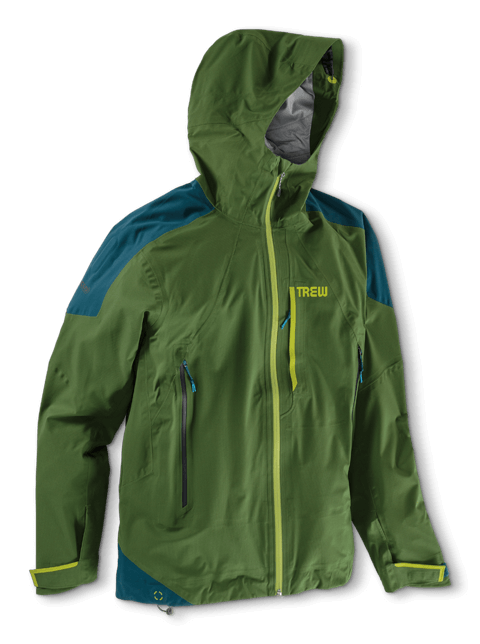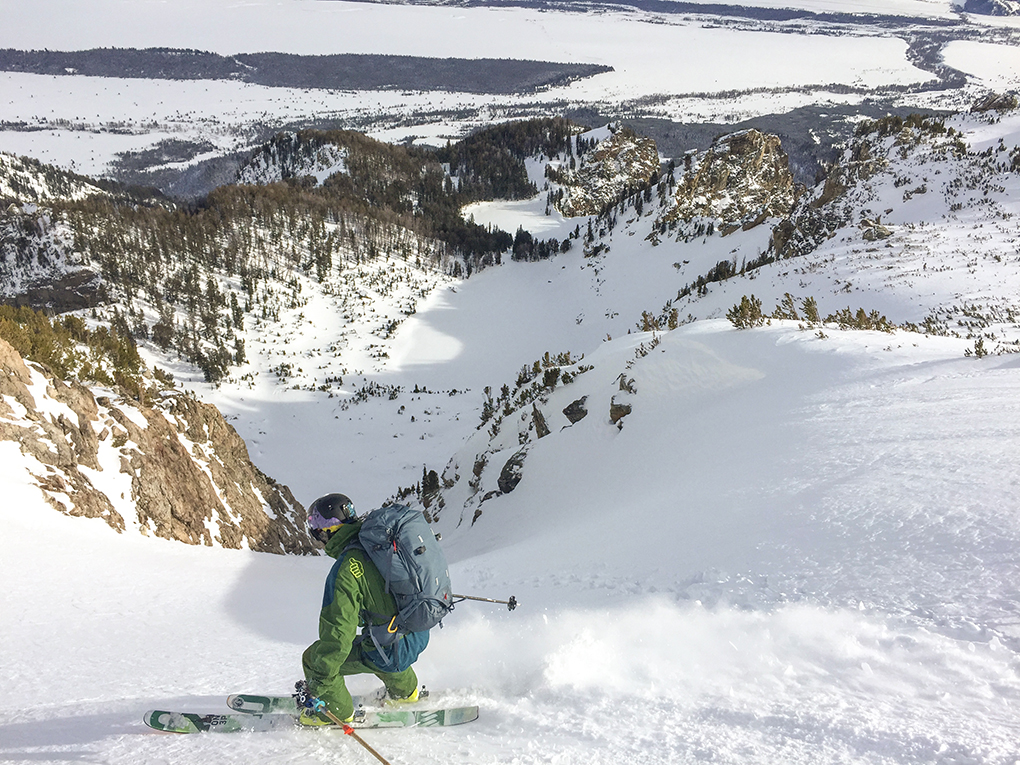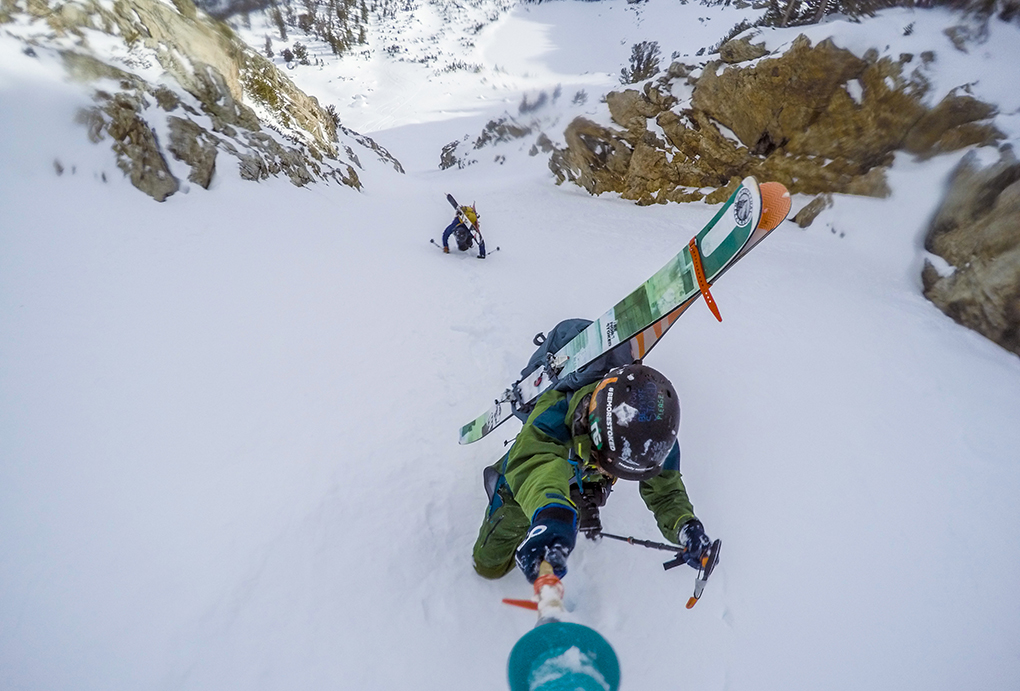
Trew Wander Jacket
Size Tested: Large
Front Zipper Length: 66.8 cm
Blister’s Measured Weight (size L): ~ 595 grams
Materials:
- Membrane: Dermizax NX (40k breathable, 20k waterproof)
- Body: 40×40 denier nylon dobby weave face, 20 denier smooth knit back
- Shoulder Yoke/ Hem: 80×70 denier plain weave nylon face, 20 denier smooth knit back
Features:
- Helmet compatible fixed hood with single point adjustment
- Underarm zip vents
- Headphone cord loop at collar
- Microsuede chin guard
- Polyester cord with rubber tipped zipper pulls
- Cohaesive embedded components
- RECCO reflector
Pockets:
- Two internal stretch-mesh drop pockets
- Two large hip pockets
- Vertical chest pocket
MSRP: $419
Reviewer:
6’, 175 lbs
Days Tested: 17
Test Locations: Teton Pass, Grand Teton National Park, & Grand Targhee, WY; Steptoe Butte & Elk River Falls, ID
This season, Trew released a line of touring-specific outerwear that features a more backcountry focused fit and features. I’ve been putting time in their new Wander Jacket and Roam Bib (review to come) in the Tetons, and it’s clear that Trew really did their homework creating the Wander.
Fit
Trew describes the fit of the Wander as “trimmer for lightweight touring,” and I found that they hit that nail squarely on the head. While I can easily fit a puffy and a thick midlayer under the Wander without feeling like the Michelin Man, there is not much extra room.

The Wander’s fit sits right between the Sweet Protection Supernaut and the Patagonia Reconnaissance Jacket. It’s a little looser and shorter than the Supernaut, and a little slimmer than the Reconnaissance.
The sleeves are a bit longer than most other size Large jackets I’ve used, and I never ran into an issue with them sliding down and exposing my wrists. While the torso isn’t excessively long, I’ve yet to run into an issue with it riding up under a backpack or in a crash.
Materials
The Wander jacket uses a 40D nylon material for the body and arms, coupled with an 80D material for the shoulders and back hem. It’s surprisingly soft and quiet, with a little bit of stretch in the fabric. There’s none of that crinkle I would usually associate with a 3L jacket. And after 15 days of touring with a heavy pack (and a couple of trips that involved ice axes or a whippet), I have yet to see any sort of wear on the face fabric.
Dermizax’s NX membrane handles waterproofing and breathability, giving the jacket a stated 20,000 mm waterproof value and an impressive 40,000 g/m2 breathability rating. (For more on what those numbers actually mean, you might want to check out our Outerwear 101 in full, but here are Sam Shaheen’s explanations from that piece:
Waterproofing
“20,000mm: what the hell does that even mean? This one is deceptively simple. It means that this membrane will not leak when exposed to the pressure generated by a 20,000mm-tall column of water. Simply, all that the waterproof rating means is the membrane can withstand a certain amount of pressure from water before it leaks. (And FYI, 704mm of water = 1 psi.)”
Breathability
“40,000g/m²/24 hours. This number specifies that over the course of 24 hours, 40,000 grams of water vapor can pass through a one-square-meter section of the laminate. Seems pretty simple, but it is not at all a simple number to measure. There is no standardized technique for measuring breathability. Therefore, companies will often use a test that provides favorable results for their particular product. This makes a comparison of breathability values from different companies completely useless, since various testing procedures can produce huge performance discrepancies.”
So that’s what those numbers mean in a lab. But how does the Wander actually perform?
Breathability
In the field, I’ve been very impressed by how well the Dermizax NX breathes. I am able to keep my pit vents closed much longer than any other jacket I’ve used, and only have to take off the Wander for extended, high-output efforts in warmer temperatures. I’d say the Wander breathes noticeably better than any Gore Pro jacket I’ve worn.

I only have limited time in a Polartec NeoShell jacket, but I felt that the Wander breathed similarly to the Flylow Genius jacket I spent time in this summer.
With the Wander’s pit zips closed, the jacket felt slightly less breathable than the Patagonia Reconnaissance Jacket. But with the vents open, the Wander dumped heat much more effectively than the Reconnaissance (which does not have pit zips).
Waterproofing, Pockets, Vents, and Hood, Etc.

Sorry the comments is slightly off topic, but any chance Blister will be reviewing the Trew Kooshin mid layer? Really curious how it stacks up against the Air-nano.
Hey Justin!
We’re planning on reviewing that piece ASAP, and I agree, the Nano-Air should be a great comparison.
Thanks!
Great, can’t wait.
Any update on the function of this jacket in the past couple years? Have you used this in heavy rain?
I’ve used this jacket for 2 winters of ski touring.
It’s awesome!
On warmer days if it’s wet or windy (20 – 40 f) I wear it over a thermal undershirt.
On cold stormy days (-20 – 15 f) I wear it over a thin fleece.
It breathes and vents incredibly well to dump heat.
It keeps me warm and dry and the hood is great – with or without a helmet.
I’m 6’3, 185 pounds and I wear a large. Perfect fit.
I can wear my puffy under or over.
“I don’t tour with headphones, but on the rare occasion I take the Wander inbounds, I appreciate this feature.”
I am amazed, is this allowed inbounds? Personally being able to hear people skiing around me makes me feel a bit safer.